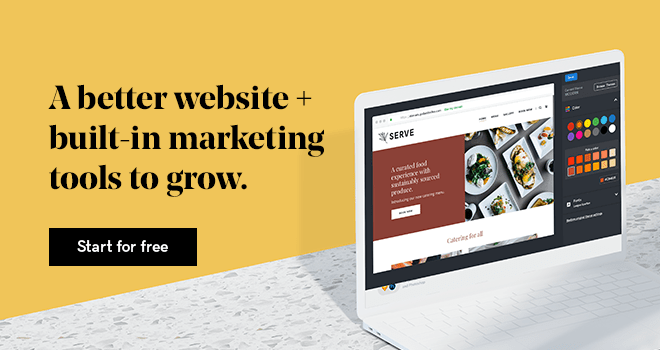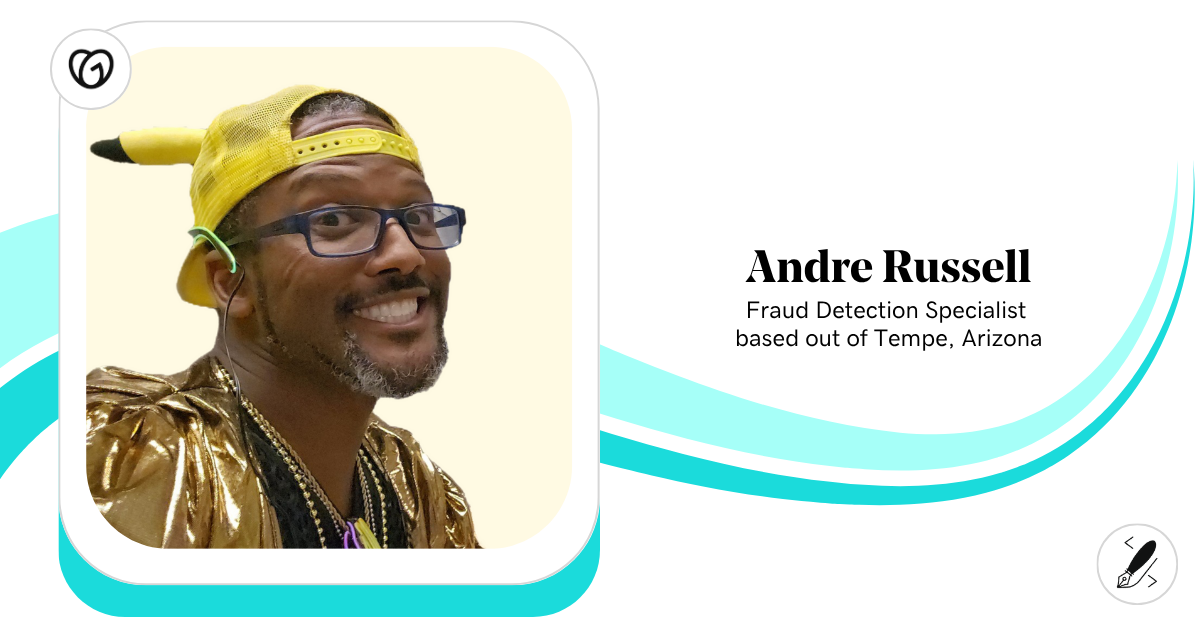One of the first questions that a marketing or business consultant will ask you is, “What is your target market? Have you developed an ideal customer profile? Who are your personas?”
If you haven’t defined them yet, you’ll probably hop to Google to figure it out. But then “how to create an ideal client profile” and “create a client persona” have an overwhelming number of results. It’s enough to make your head spin. Where do you even start?
Start here:
- Learn what target markets, ideal customer profiles, and personas are, and why you need them.
- Define your ideal client and personas.
- Use your ideal customer profiles and personas to improve all of your marketing channels.
Let’s get started!

Go from idea to online in minutes with GoDaddy Airo™
Get started now.
What are target markets, ideal customer profiles, and personas?
A target market is the broadest definition of who should use your products or services. For example, an online jewelry seller might define their target market as professional women between the ages of 25-40 with an income of $85,000 or more.
Your ideal customer profile goes deeper than the target market, examining demographics, psychographics, mindset, and needs more closely
A persona is the most detailed of all.
Creating a persona involves developing a semi-fictional characterization of your ideal customers. Many experts suggest giving your personas names (and faces from stock photo sites, of course!) to help you connect with them when creating new products and marketing messages.
Within your target market, you’re likely to have several ideal customer profiles, and each ideal customer profile could have a couple of personas.
So, why is it important to understand all three?
Your target market provides the basics of your total addressable market. You can use tools like the latest census data to estimate how many potential customers exist for your products and services, as your target market definition uses broad generalizations.
Your ideal customer profile and personas help you achieve improved results across your brand. An ideal customer understands your value, is willing to pay your worth, is excited to work with or purchase from you, and is likely to recommend you to others.
With the growth of online businesses and ecommerce, understanding your customer profiles and personas is even more critical.
If you sell knitted hats, your potential customers could be “anyone with a head” — which is quite broad, especially if you’re planning to run paid ads. This broad targeting can become expensive quickly.
By narrowing your focus to female outdoor enthusiasts between the ages of 18 and 30 who live in colder climates and have a fashion-forward focus, you can improve the targeting of your ad spend and achieve a higher ROI.
You might even name her Alyssa, who loves snowshoeing and hiking and lives in the Rocky Mountain region.
Now, let’s explore how to refine your client from “anyone with a head” to Alyssa.
How to define your ideal client and personas

First, we’ll examine what goes into defining your ideal client and where to find that information instead of making assumptions.
Elements of your ideal client profile
When creating your ideal client profile, focus on the following elements:
1. Ideal client demographics
Demographics describe who your ideal client is through objective, factual, statistical data about a specific group of people, similar to census information.
The first step in solidifying your ideal client profile is to clearly define their demographic profile.
Ideal client profile demographic profile includes:
- Age
- Gender
- Ethnicity
- Income
- Mortgage amount
- Homeowner/renter status
- Marital status
- Geographic location
- Number of children
- Vehicle type
- Occupation
- Education level
2. Ideal client psychographic
Psychographics delve into the attitudes, aspirations, interests, lifestyle, and other psychological criteria of your ideal client.
They explain why clients buy from you and what motivates their purchase decisions.
Unlike demographics, psychographics focus on more subjective information.
Psychographics focus:
- Mindset and attitude
- Beliefs and opinions
- Aspirations, goals, dreams, and wishes
- Interests (e.g., parenting tips, pet ownership, travel, wealth building, weight loss)
- Activities (e.g., hobbies, favorite books, stores, restaurants, TV shows, movies, how they spend their free time)
- Personality and values
- Lifestyle and priorities
- Spending habits
- Worries and fears
3. Ideal client behavioral analysis
Behavioral research examines your customers’ actions related to your offerings, including how they decide what to buy, when to buy, and how to buy.
Behavioral analysis can include:
- Internal marketing data, such as which types of emails they open most, which blog posts they read regularly, which email subject lines perform best, and which social media posts have the most shares.
- Analytics data to identify which actions, emails, blog posts, sales pages, ads, or other promotional activities triggered a sale.
- Reviewing real feedback—both positive and negative—from clients and customers about their experiences with your brand, products, and services, both online and offline.
- Analyzing when sales have increased and why (e.g., time of year, holidays, special promotions).
- Understanding why repeat customers continue to buy and what motivates new customers.
- Identifying who uses your product/service the most, how they use it, and when they use it (time of day, day of the week, frequency).
- Understanding how potential clients gather information before making a purchase.
- Determining how price, quality, convenience, and prestige affect their decisions.
4. Use specific metrics
Use metrics like Annual Contract Value (ACV) and Lifetime Value (LTV) to segment and prioritize target accounts. By analyzing these metrics, you can identify which accounts are the most lucrative and have the highest potential for long-term growth.
Other optional components of your ideal customer profile:
Their background story. Creating a persona’s background story involves detailing their journey to where they are today, including how they began, the challenges they’ve faced, and their current situation.
This is especially relevant when selling information-based products like online courses, ebooks, coaching, and memberships.
Ideal client destinations. Understanding not only how your client arrived but also where they want to go is essential. Knowing their goals helps you go beyond traditional marketing features and benefits to guide your customer toward their ultimate rewards and destinations.
Ideal client’s future story. Envision how your customer’s life will look after achieving their objectives. This story, combined with the background story and client destination, provides a complete narrative to address in your marketing messages.
Characteristics you don’t want. As a business owner, you can define the characteristics you don’t want in a customer based on their behaviors or niches. For example, if you’re a health coach focusing on plant-based meals, meat-eaters might be on your “no thanks” profile list.
Ideal client day-in-the-life. Defining an “Ideal Client Day-In-The-Life” involves creating a roadmap or schedule of what a typical day looks like for your ideal client persona, including aspects like:
- Morning routines (e.g., Do they wake up early and have time for coffee and reading, or do they hit snooze multiple times?)
- Breakfast habits (e.g., Do they eat a healthy breakfast or grab something on the go?)
- Family responsibilities (e.g., Do they take their kids to school or after-school activities?)
- Work habits (e.g., Do they have a cubicle, an office, or a shared workspace?)
- Personal errands and commute (e.g., How long is their commute? Do they have to dress up or is their work attire casual?)
- Evening activities (e.g., Do they cook dinner, eat out, or order takeout?)
- Relaxation habits (e.g., Do they watch TV, read, surf social media, play with kids, go for a walk, play sports, or exercise?)
- Bedtime routines (e.g., What time do they go to bed?)
- Focus areas (e.g., Where is their focus?, What are their biggest worries?)
- Stressors and frustrations (e.g., What causes them stress? What creates frustration?)
Understanding a day in your client persona’s life is valuable for crafting marketing stories in blog posts, presentations, sales pages, website content, and sales conversations.
Why? Because it allows you to connect with your ideal clients on a personal level through stories that position them as the main character.
Emphasizing empathy in developing your customer personas enables you to deeply understand and connect with your ideal clients.
By analyzing their behaviors, challenges, and motivations, you can create personas that reflect not only their demographic and psychographic profiles but also their emotional journeys and pain points.
This empathetic approach ensures that your marketing messages resonate personally, fostering stronger relationships and loyalty.
Emphasizing customer centricity in understanding customer profiles
Putting the customer at the center of your strategy is essential for creating effective ideal customer profiles.
A customer-centric approach involves gathering accurate and up-to-date data about your customers, understanding their unique challenges, and continuously refining your profiles based on their behaviors and feedback.
This approach helps you build a sales strategy that truly connects with your customers, personalizes marketing efforts, speeds up the sales cycle, and increases customer lifetime value.
By focusing on customer centricity, you ensure that your ideal customer profiles are not just theoretical constructs but real representations of the customers who drive your business forward.
This alignment enhances your ability to deliver tailored experiences, address specific pain points, and build lasting relationships with your audience.
How to define your ideal customer profile without guesswork

Are you feeling overwhelmed with everything you can and should put into your ideal customer profile?
Don’t worry — if you’ve been in business for a while, you probably have most of this information about your ideal customers at your fingertips.
1. Review your internal data
The best place to start is the information you already have about customers, including Google Analytics, social media analytics and insights, email open rates and email marketing analytics, and CRM data that you have gathered from/about clients.
2. Score your clients
Next, create a scorecard for your clients and give each one an overall score or grade. Evaluate how easy they are to work with, how much you like them, how much profit they generated, how often they buy, if they refer others, how they found you, how quickly they pay, etc.
Then take all of your top-scoring customers and look for similarities between them. What do they have in common, what similarities can you find? Add in the most profitable second-tier customers and add in any additional traits.
3. Send a survey
Surveys are a great way to gather the information you need, and open-ended questions work well for collecting psychographic data. The key to creating a successful survey is to know precisely what type of data you are looking for and what you want to learn from the respondents.
A survey is especially helpful when you want to ask former and current clients about their experience with you and your company, brand, staff and marketing efforts. When they provide feedback through a survey instead of an actual person, the answers will tend to be more honest and accurate.
4. Schedule customer interviews
Use one-on-one calls with your best customers to learn more about them. Leverage this opportunity to let them know how much you love working with them and that you’d like their help to create an updated ideal client persona — all they have to do is answer some questions and talk about themselves. These calls are especially crucial for online businesses and ecommerce providers who may have little interaction with customers when things are going well.
In your interviews, you consider asking more personal questions than you can in a survey, including:
- What do you dream of achieving?
- How have you benefitted from our product or service, and how has it changed your life or business?
- What would you say to others who aren’t sure if they should buy?
- How do you think we’re different from others?
- Where are you struggling? What is keeping you up at night?
- What interests you the most?
- What do you wish we offered, and why?
- What do you secretly hope for that no one else knows?
5. Personal research
If you don’t have existing customers to talk to or data to use, you can also do personal research. Attend networking events or join online communities to find out what people are struggling with or seeking. Watch your competitors’ social media profiles and the profiles of complementary businesses to see who is engaged and what they’re commenting on and sharing.
6. Partner up
Another great way to beef up your ideal customer profile is to exchange personas with complementary businesses that target the same types of customers. When you work with the right partners, you may uncover details you hadn’t thought of yet.
Aligning teams with your ideal customer profile (ICP)
A well-defined Ideal Customer Profile (ICP) plays a strategic role in aligning your marketing, sales, service, and executive teams. By having a unified understanding of who your ideal customers are, all departments can work towards common goals and strategies.
Strategic alignment across departments
When marketing, sales, service, and executive teams share the same ICP, it ensures that everyone is targeting the same type of customers, leading to consistent and effective engagement.
Marketing can tailor campaigns to attract the right leads, sales can focus on prospects that fit the ICP, service teams can provide relevant support, and executives can make informed decisions based on a unified customer strategy.
Integrating ICP into programs for consistent engagement
Integrating your ICP into sales and marketing programs ensures that all efforts are consistent and aligned. This integration allows for seamless transitions between marketing-generated leads and sales follow-ups, enhancing the overall customer experience.
By using ICP data to inform program strategies, you can create targeted messaging, personalized offers, and cohesive campaigns that resonate with your ideal customers.
Use your ideal customer profile to make marketing easier
Now that you’ve created your ideal customer profile, it’s time to leverage it to make your marketing more manageable and effective.
When someone feels that you are focused on them, understands them, cares about them, and wants to help them, the probability of conversion increases significantly.
1. Improve your writing and content development
When writing content for your business, select every word carefully to speak directly to your ideal client profile or personas.
This applies to all types of content, including blog posts, video scripts, webinars, sales pages, elevator pitches, social media posts, email newsletters, and presentations.
2. Create eye-catching visual design
In the same way that your words should speak directly to your personas, all of your design elements and visuals need to appeal to your ideal client profile.
Your color choices, photo selection, fonts, and even layouts should appeal to the people you want to attract while supporting your message.
3. Strong segmentation and targeting
As we discussed earlier, you may have more than one persona or ideal customer profile — each with their unique challenges and needs.
When you apply your personas to segmentation in your email marketing, remarketing, and paid ads, you can achieve a higher ROI.[AB3]
Beyond just segmenting based on personas, you can also segment based on where they are in the customer lifecycle.
4. Create and release the right products
Have you ever released a new product and the response is crickets instead of a mic drop? You’re not alone — those products can join the hallowed halls with New Coke and Cheetos Lip Balm.
When you expand your product and service line to address the known needs of your ideal client profiles specifically, you virtually guarantee a higher level of success.
5. Choose the right marketing channels
If your ideal client is a Gen Z individual planning a party to watch the big game, you will likely achieve better results on Instagram or TikTok than on LinkedIn.
When planning your marketing strategies, refer back to the behaviors described in your ideal client profile.
Understanding where they shop, where they seek news and entertainment, and where they connect with friends and family will help you decide where to invest your time and marketing dollars for the best outcomes.
Beyond the right platforms, understanding and trusting your ideal customer profile will help you identify potential collaborations, find the right influencers, and generate word of mouth that expands your reach.
Conclusion
With the ease of reaching thousands, if not millions, of potential customers using online marketing, it’s tempting to take a broad approach to your target market and ideal customers.
But to truly drive long-term success, develop deep customer relationships, and increase profitability, spend some time defining your ideal customer profile, and applying it to your marketing decisions.








